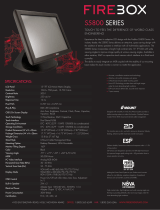
Represents a routing-capable device, such as a router or Layer 3 switch.
Represents a generic switch, such as a Layer 2 or Layer 3 switch, or a router that supports
Layer 2 forwarding and other Layer 2 features.
Represents an access controller, a unified wired-WLAN module, or the switching engine
on a unified wired-WLAN switch.
Represents an access point.
Represents a security product, such as a firewall, a UTM, or a load-balancing or security
card that is installed in a device.
Represents a security card, such as a firewall card, a load-balancing card, or a
NetStream card.
Port numbering in examples
The port numbers in this document are for illustration only and might be unavailable on your device.
About the H3C S5820X&S5800 documentation set
The H3C S5820X&S5800 documentation set includes:
Cate
or
Documents
Pur
oses
Product description and
specifications
Marketing brochures Describe product specifications and benefits.
Technology white papers
Provide an in-depth description of software features
and technologies.
Pluggable module
description
PSR150-A & PSR150-D
Series Power Modules
User Manual
Describes the appearances, features, specifications,
installation, and removal of the pluggable 150W
power modules available for the products.
PSR300-12A &
PSR300-12D Series
Power Modules User
Manual
Describes the appearances, features, specifications,
installation, and removal of the pluggable 300W
power modules available for the products.
LSVM1AC650 &
LSVM1DC650 Power
Modules User Manual
Describes the appearances, features, specifications,
installation, and removal of the pluggable 650W
power modules available for the products.
PSR750-A [ PSR750-D ]
Power Modules User
Manual
Describes the appearances, features, specifications,
installation, and removal of the pluggable 750W
power modules available for the products.
RPS User Manual
Describes the appearances, features, and
specifications of the RPS units available for the
products.
LSW1FAN and
LSW1BFAN Installation
Manual
Describes the appearances, specifications,
installation, and removal of the pluggable fan
modules available for the products.
LSWM1FANSC and
LSWM1FANSCB
Describes the appearances, specifications,
installation, and removal of the pluggable fan




















